2004 SUBARU FORESTER ignition
[x] Cancel search: ignitionPage 241 of 2870

SB-7
SEAT BELT SYSTEM
Seat Belt Warning System
3. Seat Belt Warning System
A: WIRING DIAGRAM
B: INSPECTION
TROUBLE SYMPTOM:
Seat belt warning light does not come on or go off.
Buzzer does not beep.
Step Check Yes No
1 CHECK HARNESS BETWEEN SEAT BELT
TIMER MODULE AND CHASSIS GROUND.
1) Turn the ignition switch to OFF.
2) Disconnect the connector from seat belt
timer module.
3) Measure the resistance between seat belt
timer module harness connector and chassis
ground.
Connector & terminal
(B44) No. 3 — Chassis ground:Is the resistance less than 1
Ω?Go to step 2.Repair the open
circuit of harness
between seat belt
timer module and
chassis ground.
2 CHECK POWER SUPPLY OF SEAT BELT
TIMER MODULE.
1) Turn the ignition switch to ON.
2) Measure the voltage between seat belt
timer module connector and chassis ground.
Connector & terminal
(B44) No. 9 (+) — Chassis ground (–):Is the voltage more than 10 V? Go to step 3.Repair the open
harness, short cir-
cuit and poor con-
tact of connector
between seat belt
timer module and
battery.
3 CHECK HARNESS AND SEAT BELT
SWITCH.
1) Turn the ignition switch to OFF.
2) Disconnect the connector from seat belt
timer module.
3) Hold the tang plate disconnected from seat
belt buckle.
4) Measure the resistance between seat belt
timer module harness connector and chassis
ground.
Connector & terminal
(B44) No. 6 — Chassis ground:Is the resistance less than 1
Ω?Go to step 4.Repair the short
circuit of harness
between seat belt
timer module con-
nector and chassis
ground.
4 CHECK SEAT BELT SWITCH AND HAR-
NESS.
1) Turn the ignition switch to OFF.
2) Insert the tang plate into seat belt buckle.
3) Measure the resistance between seat belt
timer module connector and chassis ground.
Connector & terminal
(B44) No. 6 — Chassis ground:Is the resistance more than 1
MΩ?Go to step 7.Go to step 5.
5 CHECK HARNESS BETWEEN SEAT BELT
TIMER MODULE AND SEAT BELT SWITCH.
Measure the resistance of harness between
seat belt timer module connector and seat belt
switch.
Connector & terminal
(B44) No. 6 — (R8) No. 2:Is the resistance less than 1
Ω?Go to step 6.Repair the open
circuit of harness
and poor contact
of connector
between seat belt
timer module con-
nector and seat
belt switch.
Page 242 of 2870

SB-8
SEAT BELT SYSTEM
Seat Belt Warning System
6 CHECK HARNESS BETWEEN SEAT BELT
SWITCH AND CHASSIS GROUND.
Measure the resistance of harness between
seat belt switch and chassis ground.
Connector & terminal
(R8) No. 1 — Chassis ground:Is the resistance more than 1
MΩ?Go to step 7.Repair the open
circuit of harness
between seat belt
switch and chas-
sis ground.
7 CHECK SEAT BELT SWITCH.
1) Hold the tang plate disconnected from seat
belt buckle.
2) Measure the resistance between seat belt
switch terminals.
Te r m i n a l s
(R8) No. 1 — (R8) No. 2:Is the resistance less than 1
Ω?Go to step 8.Replace the inner
belt assembly.
8 CHECK SEAT BELT SWITCH.
1) Insert the tang plate into seat belt buckle.
2) Measure the resistance between seat belt
switch terminals.
Te r m i n a l s
(R8) No. 1 — (R8) No. 2:Is the resistance more than 1
MΩ?Go to step 9.Replace the inner
belt assembly.
9 CHECK OPERATION OF SPEEDOMETER IN
COMBINATION METER.
Check the speedometer indicates vehicle
speed correctly.Does the speedometer operate
correctly?Go to step 10.Check the speed-
ometer circuit.
10 CHECK VEHICLE MODEL.
Check the model of vehicle.Is the vehicle MT model? Go to step 11.Go to step 13.
11 CHECK HARNESS BETWEEN VEHICLE
SPEED SENSOR AND SEAT BELT TIMER
MODULE.
1) Turn the ignition switch to OFF.
2) Disconnect the connector of vehicle speed
sensor.
3) Measure the resistance between vehicle
speed sensor harness connector and seat belt
timer module connector.
Connector & terminal
(B17) No. 1 — (B44) No. 7:Is the resistance less than 10
Ω?Go to step 12.Repair the open
harness between
vehicle speed sen-
sor and seat belt
timer module.
12 CHECK HARNESS BETWEEN VEHICLE
SPEED SENSOR AND SEAT BELT TIMER
MODULE.
Measure the resistance between seat belt
timer module harness connector and chassis
ground.
Connector & terminal
(B44) No. 7 — Chassis ground:Is the resistance more than 1
MΩ?Go to step 15.Repair the short of
harness.
13 CHECK HARNESS BETWEEN TCU AND
SEAT BELT TIMER MODULE.
1) Turn the ignition switch to OFF.
2) Disconnect the connector of TCU.
3) Measure the resistance of harness
between TCU harness connector and seat belt
timer module harness connector
Connector & terminal
(B56) No. 17 — (B44) No. 7:Is the resistance less than 10
Ω?Go to step 14.Repair the open
harness between
TCU and seat belt
timer module. Step Check Yes No
Page 243 of 2870

SB-9
SEAT BELT SYSTEM
Seat Belt Warning System
14 CHECK HARNESS BETWEEN TCU AND
SEAT BELT TIMER MODULE.
Measure the resistance between seat belt
timer module harness connector and chassis
ground.
Connector & terminal
(B44) No. 7 — Chassis ground:Is the resistance less than 10
Ω?Go to step 15.Repair the short of
harness.
15 CHECK SEAT BELT TIMER MODULE OUT-
PUT SIGNAL.
1) Turn the ignition switch to ON.
2) Measure the voltage between seat belt
timer module harness connector and chassis
ground.
Connector & terminal
(B44) No. 2 (+) — Chassis ground (–):Is the voltage more than 10 V? Go to step 16.Check the wiring
harness and com-
bination meter,
and then repair or
replace them.
16 CHECK POOR CONTACT.
Check the poor contact of seat belt warning
light circuit.Is there any poor contact
occurs?Repair the poor
contact.Go to step 17.
17 CHECK SEAT BELT TIMER MODULE.
1) Connect all connectors.
2) Lift-up the vehicle and place rigid racks.
NOTE:
Raise all wheels off floor.
3) Hold the tang plate disconnected from seat
belt buckle.
4) Start the engine, and set the vehicle speed
less than 19 km/h (12 MPH)
N
OTE:
The speed difference between front and rear
wheels may light the ABS warning light, but this
indicates no malfunction. When diagnosis is fin-
ished, perform the ABS memory clearance pro-
cedure of OBD system.
Check seat belt warning light comes on.Does the seat belt warning
light come on?Go to step 18.Replace the seat
belt timer module.
18 CHECK SEAT BELT TIMER MODULE.
1) Connect all connectors.
2) Lift-up the vehicle and place rigid racks.
N
OTE:
Raise all wheels off floor.
3) Hold the tang plate disconnected from seat
belt buckle.
4) Start the engine, and set the vehicle speed
more than 25 km/h (16 MPH).
NOTE:
The speed difference between front and rear
wheels may light the ABS warning light, but this
indicates no malfunction. When diagnosis is fin-
ished, perform the ABS memory clearance pro-
cedure of OBD system.
Check seat belt warning light comes on and
buzzer beeps.Does the seat belt warning
light come on and buzzer
beep?Temporary poor
contact of connec-
tor or harness may
be the cause.
Check the poor
contact.Replace the seat
belt timer module. Step Check Yes No
Page 244 of 2870
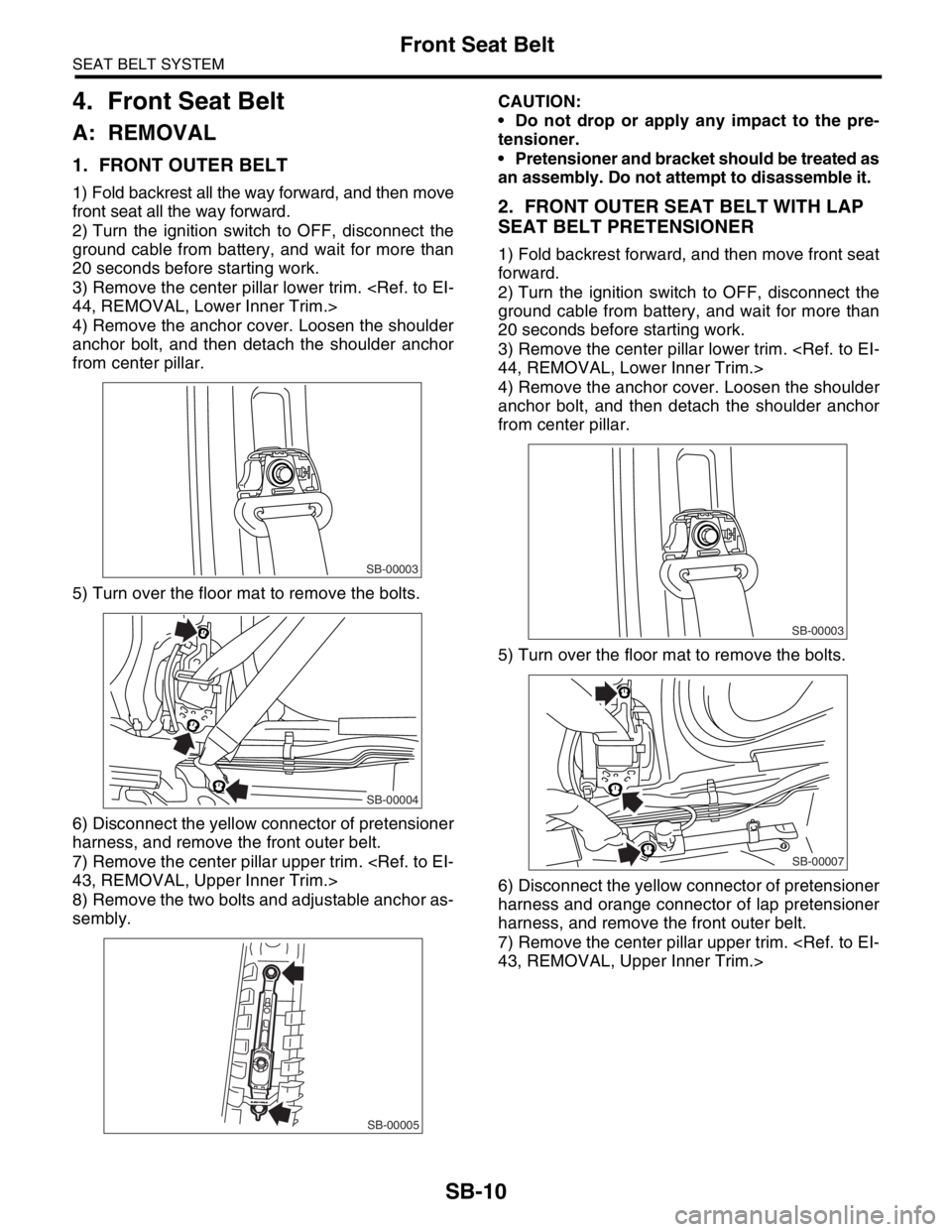
SB-10
SEAT BELT SYSTEM
Front Seat Belt
4. Front Seat Belt
A: REMOVAL
1. FRONT OUTER BELT
1) Fold backrest all the way forward, and then move
front seat all the way forward.
2) Turn the ignition switch to OFF, disconnect the
ground cable from battery, and wait for more than
20 seconds before starting work.
3) Remove the center pillar lower trim.
4) Remove the anchor cover. Loosen the shoulder
anchor bolt, and then detach the shoulder anchor
from center pillar.
5) Turn over the floor mat to remove the bolts.
6) Disconnect the yellow connector of pretensioner
harness, and remove the front outer belt.
7) Remove the center pillar upper trim.
8) Remove the two bolts and adjustable anchor as-
sembly.CAUTION:
Do not drop or apply any impact to the pre-
tensioner.
Pretensioner and bracket should be treated as
an assembly. Do not attempt to disassemble it.2. FRONT OUTER SEAT BELT WITH LAP
SEAT BELT PRETENSIONER
1) Fold backrest forward, and then move front seat
forward.
2) Turn the ignition switch to OFF, disconnect the
ground cable from battery, and wait for more than
20 seconds before starting work.
3) Remove the center pillar lower trim.
4) Remove the anchor cover. Loosen the shoulder
anchor bolt, and then detach the shoulder anchor
from center pillar.
5) Turn over the floor mat to remove the bolts.
6) Disconnect the yellow connector of pretensioner
harness and orange connector of lap pretensioner
harness, and remove the front outer belt.
7) Remove the center pillar upper trim.
SB-00003
SB-00004
SB-00005
SB-00003
SB-00007
Page 248 of 2870
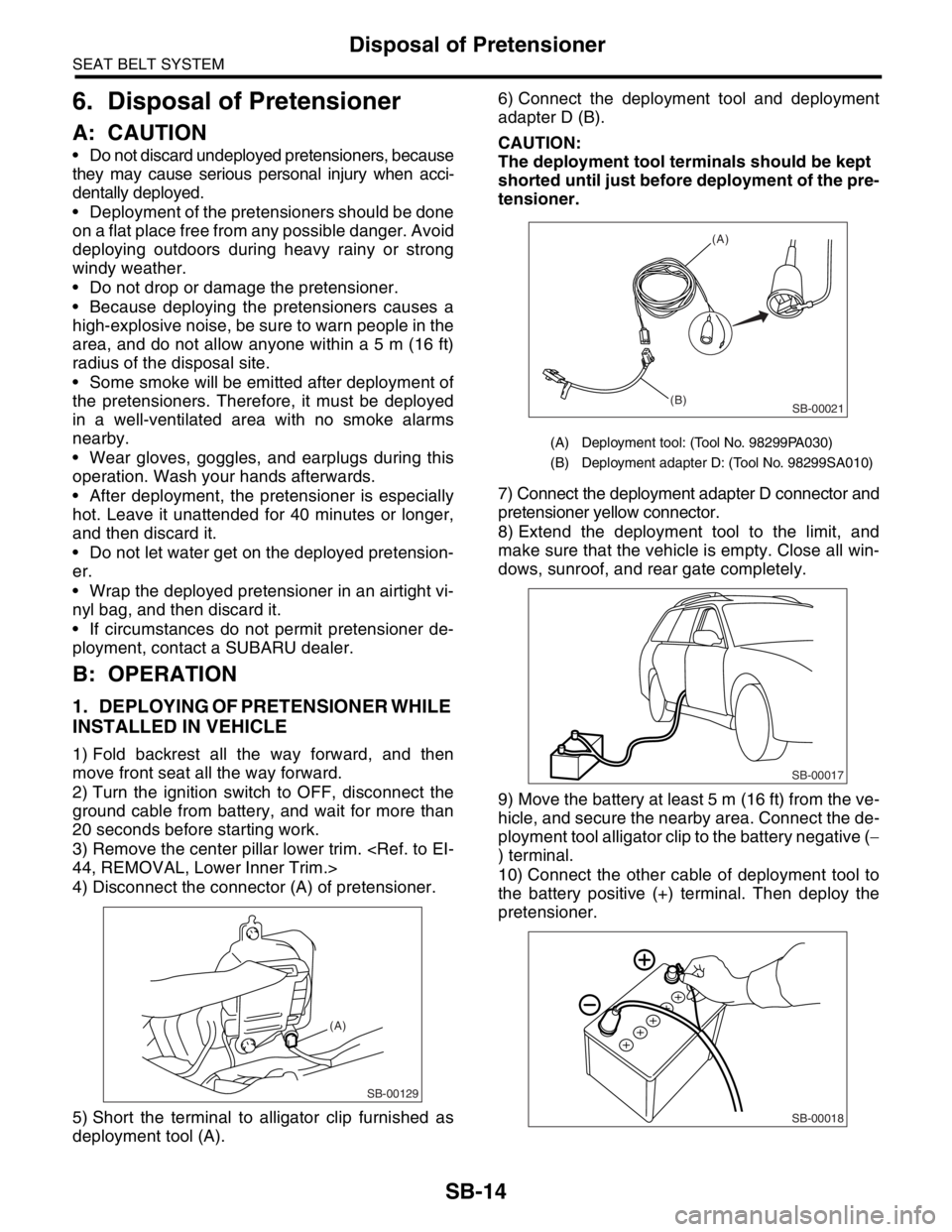
SB-14
SEAT BELT SYSTEM
Disposal of Pretensioner
6. Disposal of Pretensioner
A: CAUTION
Do not discard undeployed pretensioners, because
they may cause serious personal injury when acci-
dentally deployed.
Deployment of the pretensioners should be done
on a flat place free from any possible danger. Avoid
deploying outdoors during heavy rainy or strong
windy weather.
Do not drop or damage the pretensioner.
Because deploying the pretensioners causes a
high-explosive noise, be sure to warn people in the
area, and do not allow anyone within a 5 m (16 ft)
radius of the disposal site.
Some smoke will be emitted after deployment of
the pretensioners. Therefore, it must be deployed
in a well-ventilated area with no smoke alarms
nearby.
Wear gloves, goggles, and earplugs during this
operation. Wash your hands afterwards.
After deployment, the pretensioner is especially
hot. Leave it unattended for 40 minutes or longer,
and then discard it.
Do not let water get on the deployed pretension-
er.
Wrap the deployed pretensioner in an airtight vi-
nyl bag, and then discard it.
If circumstances do not permit pretensioner de-
ployment, contact a SUBARU dealer.
B: OPERATION
1. DEPLOYING OF PRETENSIONER WHILE
INSTALLED IN VEHICLE
1) Fold backrest all the way forward, and then
move front seat all the way forward.
2) Turn the ignition switch to OFF, disconnect the
ground cable from battery, and wait for more than
20 seconds before starting work.
3) Remove the center pillar lower trim.
4) Disconnect the connector (A) of pretensioner.
5) Short the terminal to alligator clip furnished as
deployment tool (A).6) Connect the deployment tool and deployment
adapter D (B).
CAUTION:
The deployment tool terminals should be kept
shorted until just before deployment of the pre-
tensioner.
7) Connect the deployment adapter D connector and
pretensioner yellow connector.
8) Extend the deployment tool to the limit, and
make sure that the vehicle is empty. Close all win-
dows, sunroof, and rear gate completely.
9) Move the battery at least 5 m (16 ft) from the ve-
hicle, and secure the nearby area. Connect the de-
ployment tool alligator clip to the battery negative (−
) terminal.
10) Connect the other cable of deployment tool to
the battery positive (+) terminal. Then deploy the
pretensioner.
SB-00129
(A)
(A) Deployment tool: (Tool No. 98299PA030)
(B) Deployment adapter D: (Tool No. 98299SA010)
SB-00021
(A)
(B)
SB-00017
SB-00018
Page 250 of 2870
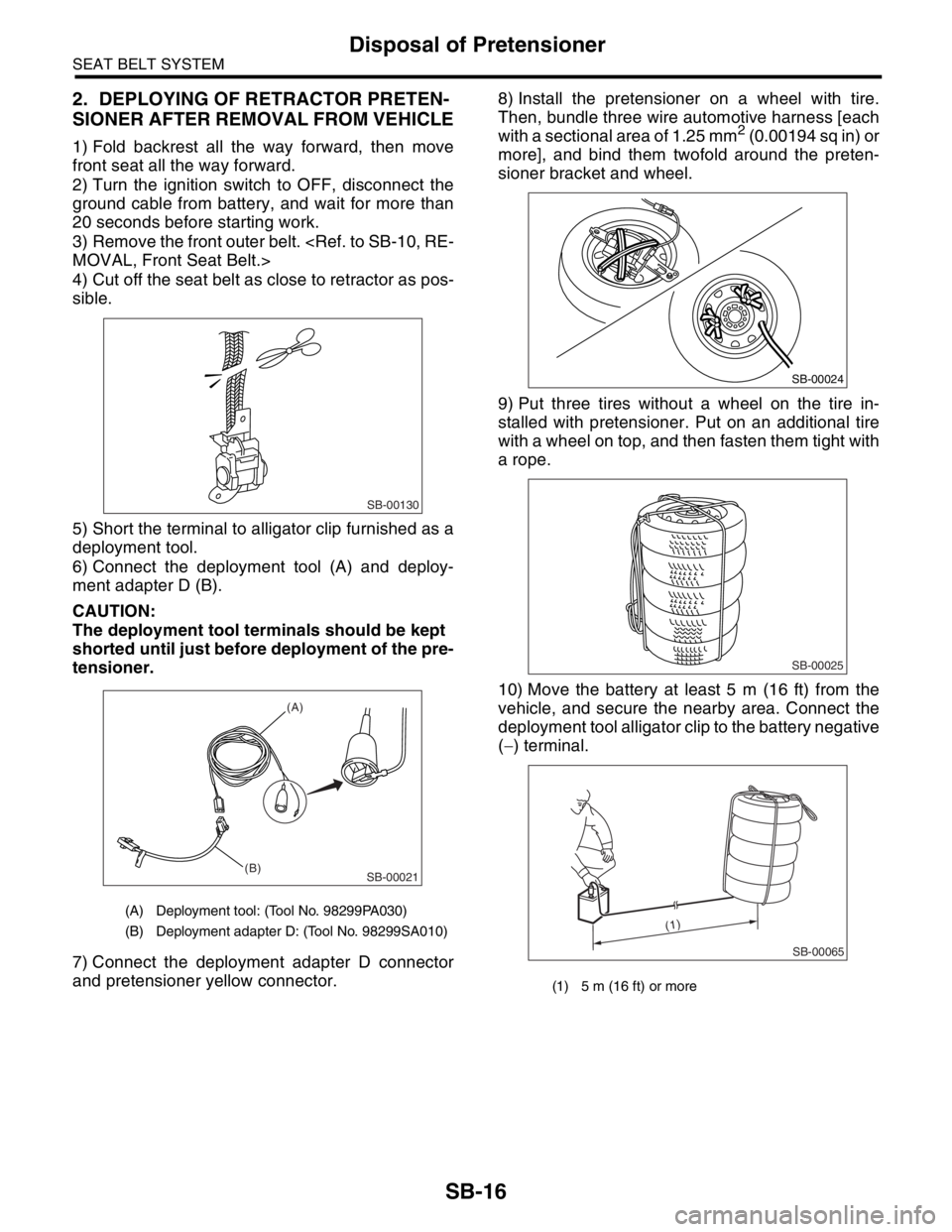
SB-16
SEAT BELT SYSTEM
Disposal of Pretensioner
2. DEPLOYING OF RETRACTOR PRETEN-
SIONER AFTER REMOVAL FROM VEHICLE
1) Fold backrest all the way forward, then move
front seat all the way forward.
2) Turn the ignition switch to OFF, disconnect the
ground cable from battery, and wait for more than
20 seconds before starting work.
3) Remove the front outer belt.
4) Cut off the seat belt as close to retractor as pos-
sible.
5) Short the terminal to alligator clip furnished as a
deployment tool.
6) Connect the deployment tool (A) and deploy-
ment adapter D (B).
CAUTION:
The deployment tool terminals should be kept
shorted until just before deployment of the pre-
tensioner.
7) Connect the deployment adapter D connector
and pretensioner yellow connector.8) Install the pretensioner on a wheel with tire.
Then, bundle three wire automotive harness [each
with a sectional area of 1.25 mm
2 (0.00194 sq in) or
more], and bind them twofold around the preten-
sioner bracket and wheel.
9) Put three tires without a wheel on the tire in-
stalled with pretensioner. Put on an additional tire
with a wheel on top, and then fasten them tight with
a rope.
10) Move the battery at least 5 m (16 ft) from the
vehicle, and secure the nearby area. Connect the
deployment tool alligator clip to the battery negative
(−) terminal.
(A) Deployment tool: (Tool No. 98299PA030)
(B) Deployment adapter D: (Tool No. 98299SA010)
SB-00130
SB-00021
(A)
(B)
(1) 5 m (16 ft) or more
SB-00024
SB-00025
SB-00065
(1)
Page 251 of 2870
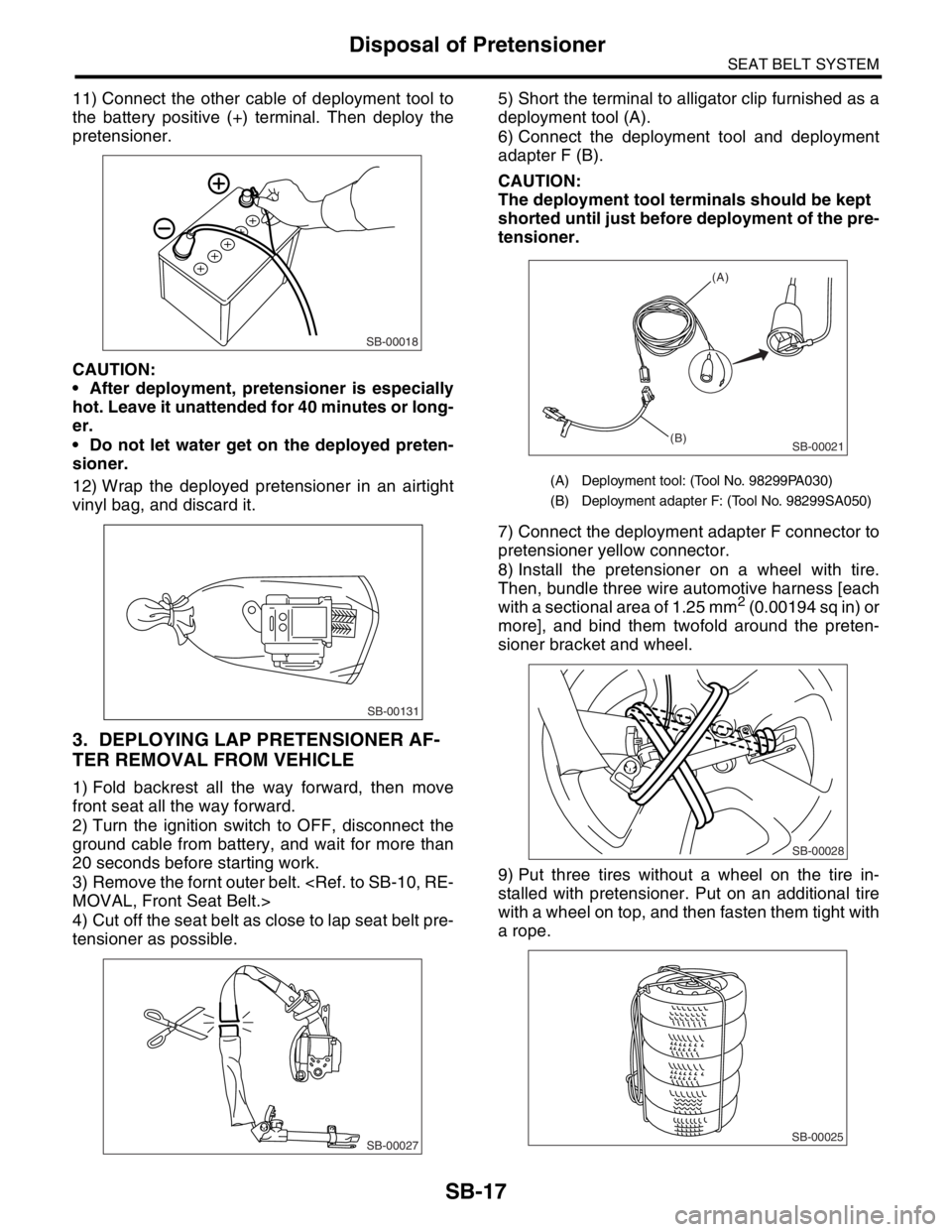
SB-17
SEAT BELT SYSTEM
Disposal of Pretensioner
11) Connect the other cable of deployment tool to
the battery positive (+) terminal. Then deploy the
pretensioner.
CAUTION:
After deployment, pretensioner is especially
hot. Leave it unattended for 40 minutes or long-
er.
Do not let water get on the deployed preten-
sioner.
12) Wrap the deployed pretensioner in an airtight
vinyl bag, and discard it.
3. DEPLOYING LAP PRETENSIONER AF-
TER REMOVAL FROM VEHICLE
1) Fold backrest all the way forward, then move
front seat all the way forward.
2) Turn the ignition switch to OFF, disconnect the
ground cable from battery, and wait for more than
20 seconds before starting work.
3) Remove the fornt outer belt.
4) Cut off the seat belt as close to lap seat belt pre-
tensioner as possible.5) Short the terminal to alligator clip furnished as a
deployment tool (A).
6) Connect the deployment tool and deployment
adapter F (B).
CAUTION:
The deployment tool terminals should be kept
shorted until just before deployment of the pre-
tensioner.
7) Connect the deployment adapter F connector to
pretensioner yellow connector.
8) Install the pretensioner on a wheel with tire.
Then, bundle three wire automotive harness [each
with a sectional area of 1.25 mm
2 (0.00194 sq in) or
more], and bind them twofold around the preten-
sioner bracket and wheel.
9) Put three tires without a wheel on the tire in-
stalled with pretensioner. Put on an additional tire
with a wheel on top, and then fasten them tight with
a rope.
SB-00018
SB-00131
SB-00027
(A) Deployment tool: (Tool No. 98299PA030)
(B) Deployment adapter F: (Tool No. 98299SA050)
SB-00021
(A)
(B)
SB-00028
SB-00025
Page 259 of 2870
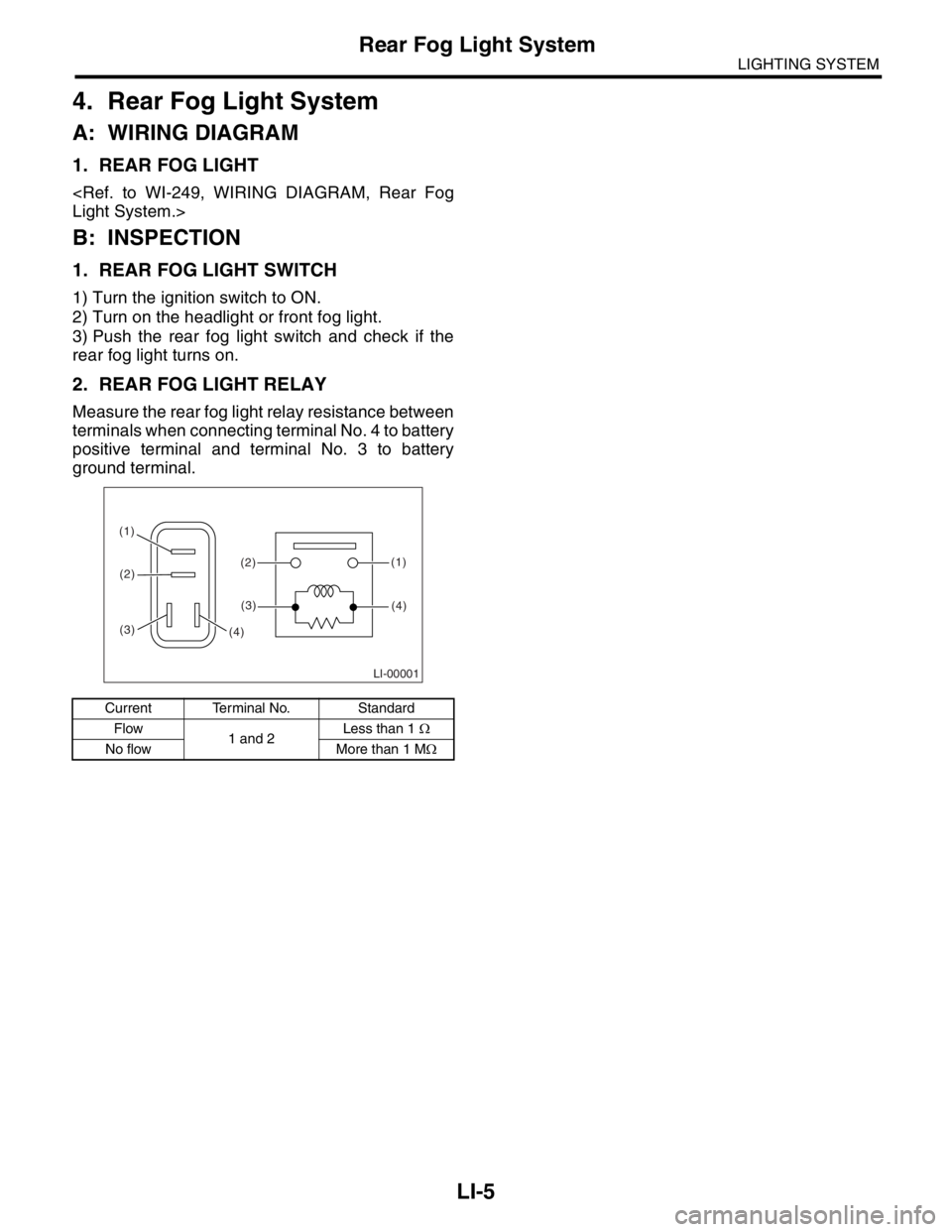
LI-5
LIGHTING SYSTEM
Rear Fog Light System
4. Rear Fog Light System
A: WIRING DIAGRAM
1. REAR FOG LIGHT
B: INSPECTION
1. REAR FOG LIGHT SWITCH
1) Turn the ignition switch to ON.
2) Turn on the headlight or front fog light.
3) Push the rear fog light switch and check if the
rear fog light turns on.
2. REAR FOG LIGHT RELAY
Measure the rear fog light relay resistance between
terminals when connecting terminal No. 4 to battery
positive terminal and terminal No. 3 to battery
ground terminal.
Current Terminal No. Standard
Flow
1 and 2Less than 1 Ω
No flow More than 1 MΩ
LI-00001
(1)
(2) (1)
(4)(2)
(3)
(3)(4)